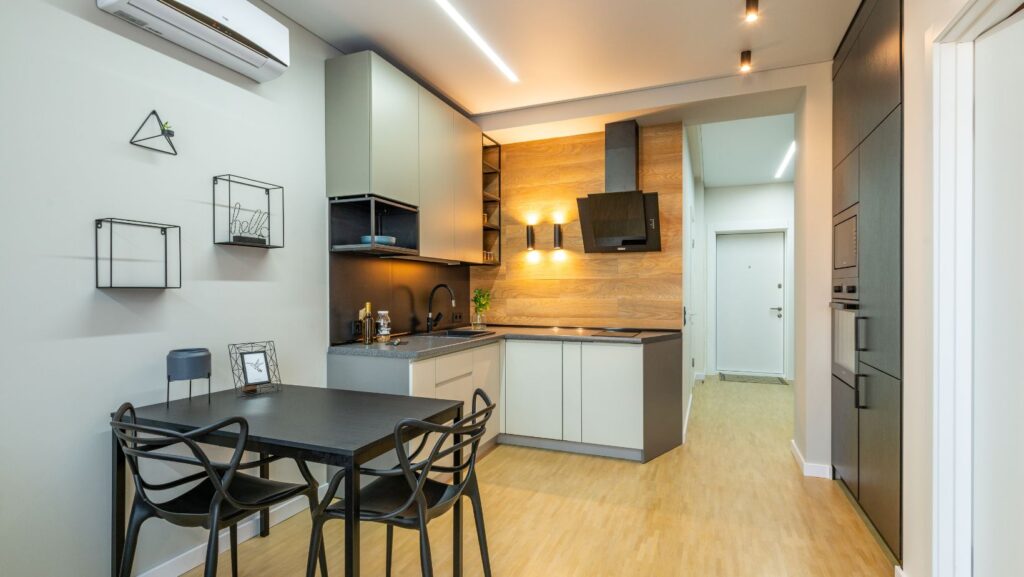Key Takeaways
- Importance of Dining Rooms: The dining room is the heart of the home, and a makeover can enhance its function and aesthetic appeal, making it a more inviting space for family gatherings and entertaining.
- Transformation Options: Dining room makeovers can range from minor updates like new paint and lighting to major renovations involving furniture selection and structural changes, allowing for a variety of design preferences and budgets.
- Trends in Design: Current dining room trends lean towards minimalist designs and bold accent walls, promoting simplicity and functionality while allowing for personal expression through color and decor.
- Key Elements for Success: Successful makeovers focus on selecting the right furniture and effective lighting. Multi-functional furniture and layered lighting contribute significantly to the overall experience and atmosphere of the space.
- DIY vs. Professional: Homeowners can choose between DIY projects for cost savings and personalization or hire professionals for expertise and high-quality results, depending on project complexity and individual skill levels.
- Budgeting Essentials: Establishing a clear budget is crucial for effective makeovers, prioritizing essential updates and monitoring spending to ensure the project stays within financial limits while maximizing aesthetic and functional benefits.
The dining room often serves as the heart of the home, where families gather to share meals and create lasting memories. However, over time, even the most cherished spaces can feel outdated or uninspired. A dining room makeover can breathe new life into this important area, transforming it into a stylish and inviting environment.
From simple updates like new paint and decor to more extensive renovations, the possibilities for revitalizing a dining room are endless. Whether it’s a cozy nook for intimate dinners or a grand space for entertaining, a thoughtful makeover can enhance both functionality and aesthetics. Discover how to elevate your dining experience and make the most of this essential space.
Dining Room Makeovers
 Dining room makeovers involve transforming the aesthetics and functionality of this essential space. Efforts can include minor modifications like repainting walls, adding new lighting fixtures, and updating tableware. Updates to furniture, such as replacing an old table or incorporating additional seating options, enhance both style and comfort.
Dining room makeovers involve transforming the aesthetics and functionality of this essential space. Efforts can include minor modifications like repainting walls, adding new lighting fixtures, and updating tableware. Updates to furniture, such as replacing an old table or incorporating additional seating options, enhance both style and comfort.
Extensive renovations may involve structural changes, such as altering the layout, installing new flooring, or adding built-in storage solutions. Incorporating modern technology, like smart lighting systems or sound systems, improves usability.
Design themes play a crucial role in dining room makeovers. Options range from rustic farmhouse styles to sleek modern aesthetics, allowing homeowners to tailor their space to personal tastes.
Budget considerations often dictate the extent of the makeover. Establishing a clear budget helps prioritize changes. DIY projects provide cost savings while professional services elevate design quality.
Successful dining room makeovers consider durability and maintenance. Choosing materials that withstand wear and tear ensures longevity.
These makeovers ultimately aim to create an inviting environment, enhancing the overall dining experience for families and guests alike.
Popular Trends In Dining Room Design
 Dining room design trends focus on creating spaces that blend functionality with aesthetics. Innovative approaches and bold choices define the current landscape of dining room makeovers.
Dining room design trends focus on creating spaces that blend functionality with aesthetics. Innovative approaches and bold choices define the current landscape of dining room makeovers.
Minimalist approaches emphasize simplicity and functionality in dining room design. Clean lines, uncluttered spaces, and muted color schemes create a serene atmosphere. Key elements include:
- Furniture: Select streamlined furniture with no ornate detailing. Opt for rectangular or round tables made from materials like wood or metal.
- Decor: Use limited decor items, focusing on a few statement pieces. Incorporate functional decor, such as simple centerpieces or geometric table settings.
- Lighting: Choose understated lighting fixtures. Pendant lights or recessed lighting provide illumination without overwhelming the space.
- Textures: Integrate varying textures, such as soft textiles and polished surfaces, to create visual interest while maintaining a minimalist aesthetic.
- Accent Walls: Use strong colors like deep blues, rich greens, or vibrant reds on a single wall to create a striking focal point.
- Furniture: Choose colorful chairs or tables that contrast with neutral surroundings. Brightly colored furniture pieces can serve as conversation starters.
- Textiles: Incorporate bold patterns and colors in table linens, curtains, or cushions. Use prints that complement the overall color scheme.
- Art: Hang large, colorful artwork or murals to enhance visual appeal. Inspired pieces can reflect personal style and add character to the room.
Essential Elements For A Successful Makeover
Successful dining room makeovers hinge on key elements that elevate the space’s aesthetics and functionality. Focusing on furniture selection and lighting choices ensures a well-balanced environment that meets both style and purpose.
Furniture Selection
Choosing the right furniture significantly impacts the dining room’s atmosphere. Consideration of size and layout is crucial; large tables may overwhelm smaller rooms, while minimalist options enhance space in compact areas. Priority should be given to multi-functional pieces, such as benches or extendable tables, which maximize utility. Material durability is vital; hardwoods and quality upholstery withstand daily use and maintain an inviting look. Different styles, from contemporary to traditional, should resonate with your overall design theme, ensuring a cohesive aesthetic.
Lighting Choices
Effective lighting transforms the dining room experience. Layered lighting creates depth; combine ambient, task, and accent lighting for versatility. A centerpiece chandelier adds drama and serves as a focal point. Sconces can create ambient light, enhancing the room’s overall warmth. Incorporating dimmable options allows for customizable illumination, catering to various occasions, from family dinners to entertaining guests. Consider energy-efficient LED fixtures for sustainability while maintaining style.
DIY Vs. Professional Makeovers
DIY dining room makeovers empower individuals to personalize their spaces creatively. Cost savings often attract homeowners to this approach, as labor expenses are typically eliminated. DIY projects include tasks such as painting, reupholstering furniture, or crafting custom decor items. Skills in basic carpentry or design enhance the ability to execute more complex tasks.
Professional makeovers offer expertise and ease for those lacking time or experience. Professionals bring specialized knowledge and advanced techniques, ensuring high-quality results. Hiring a designer or contractor simplifies the process, especially for structural modifications or large-scale renovations. Collaboration with experts helps refine design ideas and navigate material selection effectively.
When considering DIY projects, individuals should assess skill levels and available time. Professionals provide valuable guidance, yet costs can escalate based on the project’s complexity. DIY options suit smaller updates, while professionals excel in comprehensive renovations. Balancing budget, time, and desired outcomes guides the decision between DIY and professional assistance.
Budgeting For Your Dining Room Makeover
Establishing a budget sets the foundation for a successful dining room makeover. This process includes determining how much to spend, prioritizing essential updates, and exploring creative solutions to make the most of the investment.
Determine Your Budget
- Identify total funds: Calculate available funding for the entire project.
- Allocate for categories: Designate portions for furniture, decor, lighting, and potential renovations.
- Include hidden costs: Consider additional expenses, such as permits, tools, and contractor fees.
Prioritize Expenses
- Focus on essentials: Prioritize needs over wants, addressing items that directly affect functionality and aesthetics first.
- Plan for splurges: Allocate a portion for high-impact features, like a stunning light fixture or a durable dining table.
- Evaluate alternatives: Consider options like second-hand furniture or DIY projects to stretch the budget.
Monitor and Adjust
- Track spending: Keep a detailed record of all purchases to prevent overspending.
- Be flexible: Allow for adjustments in expenditures if priorities evolve during the project.
- Review regularly: Frequently reassess the budget and make necessary changes to ensure alignment with goals.
- Consult experts: When significant renovations are planned, consider hiring a designer for budget-focused advice.
- Gather estimates: Request detailed quotes from contractors to understand potential costs in advance.
- Explore financing options: Research financial plans or loans that suit project costs comfortably, if necessary.
Careful budgeting enables a well-planned approach to dining room makeovers, enhancing both the space’s aesthetics and its overall functionality without exceeding financial constraints.
Minimalist Approaches
Revamping a dining room offers an exciting opportunity to enhance both its function and style. By embracing creative ideas and thoughtful planning, anyone can transform this essential space into a welcoming environment. Whether opting for simple updates or comprehensive renovations, the key lies in aligning personal taste with practical needs.
Balancing budget considerations with design choices ensures that the makeover remains both affordable and impactful. As trends evolve, staying informed about innovative solutions can spark inspiration for future updates. Ultimately, a well-designed dining room not only elevates the dining experience but also fosters cherished moments with family and friends.


